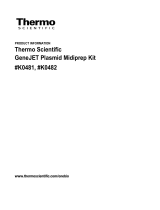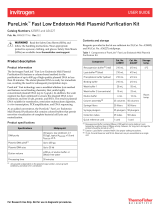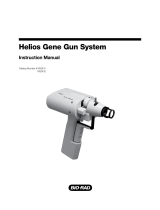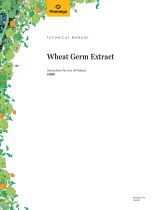Page is loading ...

For Research Use Only. Not for use in diagnostic procedures.
ProQuest™ Two-Hybrid System
USER GUIDE
A sensitive method for detecting protein-protein interactions
Catalog Number PQ1000101
Publication Number MAN0000537
Revision B.0

Life Technologies Corporation | 5781 Van Allen Way | Carlsbad, California 92008 USA
Revision history:MAN0000537 B.0 (English)
Revision Date Description
B.0 1 December 2023 Removed Cat. No. PQ10002-01. Removed references. Updated Gateway™ Technology Open Architecture Policy.
A.0 24 October 2005 New document for ProQuest™ Two-Hybrid System.
The information in this guide is subject to change without notice.
DISCLAIMER: TO THE EXTENT ALLOWED BY LAW, THERMO FISHER SCIENTIFIC INC. AND/OR ITS AFFILIATE(S) WILL NOT BE
LIABLE FOR SPECIAL, INCIDENTAL, INDIRECT, PUNITIVE, MULTIPLE, OR CONSEQUENTIAL DAMAGES IN CONNECTION WITH OR
ARISING FROM THIS DOCUMENT, INCLUDING YOUR USE OF IT.
Important Licensing Information: This product may be covered by one or more Limited Use Label Licenses. By use of this product,
you accept the terms and conditions of all applicable Limited Use Label Licenses.
TRADEMARKS: All trademarks are the property of Thermo Fisher Scientific and its subsidiaries unless otherwise specified.
©2005-2023 Thermo Fisher Scientific Inc. All rights reserved.

Contents
■CHAPTER1Productinformation .................................................. 8
Contents ....................................................................... 8
Contents and storage ....................................................... 8
Shipping and storage ........................................................ 8
ProQuest™ Two-Hybrid system reagents ....................................... 9
GenotypeMaV203 .......................................................... 9
Accessory products ............................................................ 10
Introduction ............................................................... 10
MaV203 competentcells ................................................... 10
Accessory products ........................................................ 10
3-Aminotriazole ........................................................... 11
Zymolyase™............................................................... 11
Cycloheximide ............................................................ 11
Yeastmedia ............................................................... 12
■CHAPTER2General introduction ................................................ 13
Overview ...................................................................... 13
ProQuest™ Two-Hybrid System .............................................. 13
Supportedapplications ..................................................... 13
Advantages of the ProQuest™ Two-Hybrid system ............................. 13
Systemcomponents ....................................................... 13
Gateway™ Technology ...................................................... 14
Purpose of thismanual ..................................................... 14
Important ................................................................. 14
General description of the Two-Hybrid system ..................................... 15
Two hybrid proteins ........................................................ 15
Reporters under control of UAS ............................................. 16
Interaction drives expression of reporters ..................................... 16
Evaluating reporter gene expression ......................................... 17
Screening Two-Hybrid libraries .............................................. 17
Falsepositives ............................................................ 17
Advanced™ Two-Hybrid systems ............................................ 18
ProQuest™ Two-Hybrid system .................................................. 19
Verifying Two-Hybrid interaction ............................................. 19
Forward Two-Hybrid library screen ........................................... 19
Cloning vectors ............................................................ 19
ProQuest™ Two-Hybrid System User Guide 3

Two-Hybrid control vectors ................................................. 20
MaV203 yeast strain ....................................................... 21
Reducing falsepositives .................................................... 21
Three reportergenes ....................................................... 21
Fourphenotypes .......................................................... 22
Low-Copy-Number vectors ................................................. 22
Gateway™compatibility .................................................... 22
Plasmidshuing .......................................................... 23
Features of pDEST™32 ..................................................... 23
Features of pDEST™22 ..................................................... 23
Features of pEXP™-AD502 .................................................. 24
Plasmidisolation .......................................................... 24
Features of yeast strainMaV203 ............................................. 24
GenotypeMaV203 ......................................................... 25
Considerations in designing a Two-Hybrid screen .................................. 26
Introduction ............................................................... 26
Transcriptional activator .................................................... 26
Proteinfamily ............................................................. 26
Expression pattern ......................................................... 26
Interaction artifacts ........................................................ 27
Confirmation of interaction .................................................. 27
Applications for ProQuest™ Two-Hybrid screen .................................... 28
Supportedapplications ..................................................... 28
Verifying interaction ........................................................ 28
Forward Two-Hybrid library screen ........................................... 28
■CHAPTER3Verifying interaction ................................................. 29
Introduction ................................................................... 29
Flowchart ................................................................. 30
Methods ...................................................................... 31
Generating bait and preyplasmids ........................................... 31
Testing specific Two-Hybrid interaction ....................................... 40
■CHAPTER4Forward Two-Hybrid library screen ................................ 49
Introduction ................................................................... 49
Required reagents before starting ............................................ 49
Choosing Two-Hybrid library ................................................ 49
Bait-Specific positive interaction control ...................................... 50
Flowchart ................................................................. 50
Methods ...................................................................... 51
Testingbait ............................................................... 51
Screening forward Two-Hybrid library ........................................ 55
What to do next ........................................................... 61
Interpretation of results ..................................................... 66
Contents
4ProQuest™ Two-Hybrid System User Guide

■CHAPTER5Troubleshooting ..................................................... 69
Generating bait and preyplasmid ................................................ 69
Testing specific Interaction/ retransformationassay ................................ 70
Testingbait .................................................................... 71
Forward two hybrid screen ...................................................... 72
Isolation of preyplasmid ........................................................ 73
■APPENDIXA Gateway™ recombination reactions ............................. 74
Introduction ................................................................... 74
Recombination reactions ........................................................ 74
BP reaction ............................................................... 74
LR reaction ............................................................... 74
Characteristics of modified att sites .............................................. 75
Specificity of modified att sites .................................................. 75
Vectors in ProQuest™ system .................................................... 75
Gateway™ vectors .............................................................. 76
Selection of Gateway™ vectors .................................................. 76
ccdBgene .................................................................... 77
Propagating Gateway™ vectors .................................................. 77
■APPENDIXBRecipes ............................................................. 78
Recipedetails ................................................................. 78
SC medium and plates ..................................................... 78
LB (Luria-Bertani) medium and plates ........................................ 79
5FOA plates ............................................................... 79
3AT plates ................................................................ 79
Cycloheximide plates ...................................................... 80
10xLiAc .................................................................. 80
10xTE .................................................................... 80
1X LiAc/0.5XTE ........................................................... 80
1X LiAc/1XTE ............................................................. 80
1X LiAc/40% PEG-3350/1XTE .............................................. 80
Zbuer ................................................................... 81
■APPENDIXCSupplementary protocols ......................................... 82
Generating a cDNA library using Three-Frame ..................................... 82
Three-Frame .............................................................. 82
Advantages of the Three-Frame libraries ...................................... 82
Three reading frame adapters ............................................... 82
Reduced5’UTRs .......................................................... 83
Contents
ProQuest™ Two-Hybrid System User Guide 5

Reduced Poly-Asequences ................................................. 83
Preparation of Three-Frame libraries .......................................... 83
Library scale yeast transformation (Purchased competentCells) ..................... 84
Introduction ............................................................... 84
Library scale competent yeastcells .......................................... 84
Transformants per screen ................................................... 84
Materialsneeded .......................................................... 84
Important ................................................................. 85
Transformation procedure ................................................... 85
Preparing and transforming competent cells (LibraryScale) .......................... 87
Introduction ............................................................... 87
Important ................................................................. 87
Materialsneeded .......................................................... 87
Preparing competentcells .................................................. 88
Transforming competentcells ............................................... 88
Replica Plating/Replicacleaning ................................................. 89
Introduction ............................................................... 89
Essentialtips .............................................................. 89
Procedure for replicaplating ................................................ 90
Procedure for replicacleaning ............................................... 90
Cleaningvelvets ........................................................... 90
Alternatives to replicaPlating/Cleaning ....................................... 90
Quantitative β-Galactosidase assays in liquid cultures .............................. 91
Introduction ............................................................... 91
Note ..................................................................... 91
ONPGassay .............................................................. 91
CPRGassay .............................................................. 92
Plasmidshuing ............................................................... 94
Introduction ............................................................... 94
Procedure for plasmidshuing .............................................. 94
■APPENDIXDMaps and features of vectors .................................... 96
pDEST™32 .................................................................... 97
Map of pDEST™32 ......................................................... 97
pDEST™22 .................................................................... 98
Map of pDEST™22 ......................................................... 98
Features of vectors pDEST™32 and pDEST™22 .................................... 99
Features of vectors ........................................................ 99
pEXP™-AD502 ................................................................ 100
Map of pEXP™-AD502 ..................................................... 100
MCS of pEXP™-AD502 .................................................... 101
pEXP™32-Krev1 .............................................................. 102
Map of pEXP™32-Krev1 ................................................... 102
Contents
6ProQuest™ Two-Hybrid System User Guide

pEXP™22-RalGDS-wt, m1,m2 .................................................. 103
Maps of pEXP™22-RalGDS-wt, m1,m2 ..................................... 103
Map of pENTR™-gus .......................................................... 105
Description .............................................................. 105
Map of control vector ..................................................... 105
■APPENDIXESupplementalinformation ....................................... 106
Gateway™ Technology ......................................................... 106
■APPENDIXFSafety .............................................................. 107
Chemicalsafety .............................................................. 108
Biological hazardsafety ....................................................... 109
■Documentation and support ...................................................... 110
Customer and technical support ................................................ 110
Limited product warranty ...................................................... 110
Contents
ProQuest™ Two-Hybrid System User Guide 7

Product information
IMPORTANT! Before using this product, read and understand the information in the “Safety” appendix
in this document.
Contents
Contents and storage
Table1ProQuest™ Two-Hybrid System (Cat. No. PQ10001-01)
Component[1] Storage
ProQuest™ Vectors -80°C
ProQuest™ Control Vectors -20°C
LR Clonase™ II -20°C
[1] All components are shipped on dry ice.
Shipping and storage
The ProQuest™ Two-Hybrid System is shipped as described below. Upon receipt, store each item as
detailed below.
Box Component Shipping Storage
1 ProQuest™ Vectors Dry ice -80℃
2 ProQuest™ Control Vectors Dry ice -20℃
3 LR Clonase™ II Dry ice -20℃
1
8ProQuest™ Two-Hybrid System User Guide

ProQuest™ Two-Hybrid system reagents
The following reagents are included with the ProQuest™ Two-Hybrid System Reagents.
ProQuest™ Vectors Box (Store the reagents at -80℃)
Reagent Composition Amount
pDEST™22 Liquid in TE Buer, pH 8.0 6µg
pDEST™32 Liquid in TE Buer, pH 8.0 6µg
MaV203 glycerol stock YPAD + 20% glycerol 0.5mL
ProQuest™ Control Vectors Box (Store the reagents at -20℃)
Reagent Composition Amount
pEXP™-AD502 Liquid in TE Buer, pH 8.0 1µg
pEXP™32/Krev1 Liquid in TE Buer, pH 8.0 10µg
pEXP™22/RalGDS-wt Liquid in TE Buer, pH 8.0 10µg
pEXP™22/RalGDS-m1 Liquid in TE Buer, pH 8.0 10µg
pEXP™22/RalGDS-m2 Liquid in TE Buer, pH 8.0 10µg
LR Clonase™ II Box
(Store at -20℃ for up to 6 months. For long-term storage, store at -80℃.)
Reagent Composition Amount
Gateway™ LR Clonase™ II Enzyme Mix Proprietary 40µL
Proteinase K Solution Solution 2µg/µL in:
10 mM Tris-HCl, pH 7.5
20 mM CaCl2
50% glycerol
40µL
pENTR™-gus Positive Control 50ng/µL in TE Buer, pH 8.0 20µL
Genotype MaV203
The genotype of MaV203 is as follows:
MaV203 (MATα, leu2-3,112, trp1-901, his3Δ200, ade2-101, gal4Δ, gal80Δ, SPAL10::URA3, GAL1::lacZ,
HIS3UAS GAL1::HIS3@LYS2, can1R, cyh2R)
Chapter1Product information
Contents 1
ProQuest™ Two-Hybrid System User Guide 9

Accessory products
Introduction
The products listed in this section may be used with the ProQuest™ Two-Hybrid System. For more
information, see (thermofisher.com).
MaV203 competent cells
We provide a glycerol stock of the MaV203 yeast strain. A protocol is provided to perform small-scale
transformations using this stock. To limit your workload, purchase competent MaV203cells, subclone
scale. Alternatively, prepare competent cells using the S. c. EasyComp™ Kit, which can be frozen for
later use. For large-scale applications, such as a forward two-hybrid library screen, we recommend
obtaining MaV203 Competent Cells, Library Scale to get the highest transformation eciency and to
limit your workload.
Item Amount Catalog no.
MaV203 Competent Cells, Library Scale 2 x 0.55ml 11281011
MaV203 Competent Cells, Subclone Scale 4 x 0.10ml 11445012
S. c. EasyComp™ Kit 1 kit K505001
Note: For your convenience, we have added a protocol in the (Appendix C, “Supplementary protocols”)
to make your own large-scale competent cells using MaV203 cells provided with the kit.
Accessory products
Some of the reagents supplied in the ProQuest™ Two-Hybrid System and as well as other products
suitable for use with the kit are available separately from thermofisher.com. Ordering information is
provided below.
Item Amount Catalog no.
PureLink™ HQ Mini Plasmid DNA Purification Kit 100 preps K210001
PureLink™ HiPure Plasmid Miniprep Kit 25 preps
100 preps
K210002
K210003
PureLink™ HiPure Plasmid Midiprep Kit 25 preps
50 preps
K210004
K210005
5‑bromo-4‑chloro-3‑indolyl-D-galactopyranoside (X-Gal), 100mg
1g
15520034
15520018
Denatured Sheared Salmon Sperm DNA 5 x 1mL 15632011
OneShot™ TOP10 Electrocomp™ E. coli 10 reactions
20 reactions
C404050
C404052
Chapter1Product information
Accessory products
1
10 ProQuest™ Two-Hybrid System User Guide

(continued)
Item Amount Catalog no.
Platinum™ PCR SuperMix HiFi 100 reactions 12532016
Platinum™ PCR SuperMix 100 reactions 11306016
Platinum™ Taq DNA Polymerase 100 reactions 10966018
S.N.A.P.™ Gel Purification Kit 25 reactions K199925
2.5mM dNTP Mix 1mL R72501
Gateway™ LR Clonase™ II Enzyme Mix 20 reactions
100 reactions
11791020
11791100
Gateway™ BP Clonase™ II Enzyme Mix 20 reactions
100 reactions
11789020
11789100
Proteinase K Solution 100mg
1g
25530015
25530031
pCR™8/GW/TOPO™ TA Cloning™ Kit 20 reactions K250020
Gentamicin Reagent Solution (10mg/mL), liquid 10mL
10 x 10mL
15710064
15710072
SOC Medium 10 x 10mL 15544034
LB Agar, powder (Lennox L Agar) 500g
2.5kg
22700025
22700041
LB Broth Base, powder (Lennox L Broth Base) 500g
2.5kg
12780052
12780029
3-Aminotriazole
For selection of HIS+ transformants in S. cerevisiae, you will need to obtain 3‑aminotriazole, which is
available from Millipore Sigma, St. Louis, MO, (Catalog No. A8056).
Zymolyase™
For isolation of yeast DNA you need Zymolyase™ (1.5 U/µL), which is available from G-Biosciences,
St.Louis, MO (Catalog no. 786-036).
Cycloheximide
For Plasmid shuing (see “Plasmid shuing” on page94), you will need to obtain cycloheximide,
which is available from Millipore Sigma, St. Louis, MO (Catalog No. C1988).
Chapter1Product information
Accessory products 1
ProQuest™ Two-Hybrid System User Guide 11

General introduction
Overview
ProQuest™ Two-Hybrid System
The ProQuest™ Two-Hybrid System is a genetic method for detecting interactions between proteins in
vivo in the yeast Saccharomyces cerevisiae. The ProQuest™ Two-Hybrid System draws on modifications
by Chevray & Nathans and incorporates Gateway™ Technology.
Supported applications
The ProQuest™ Two-Hybrid System supports three types of applications:
•Verifying an interaction between two known proteins or protein domains for which there is a
prior reason to expect an interaction (testing two-hybrid interactions); see Chapter 3, “Verifying
interaction”.
•Screening a library for novel proteins that specifically interact with a known bait (forward two-hybrid
library screen); see Chapter 4, “Forward Two-Hybrid library screen”.
Advantages of the ProQuest™ Two-Hybrid system
The ProQuest™ Two-Hybrid System is a system designed to enable detection of protein-protein
interactions and has been modified to decrease false positives. The primary modifications include:
•Uses low-copy-number (ARS/CEN) vectors to control over-expression and increase reproducibility
•Contains three dierent reporter genes with independent promoters to rapidly weed out false
positives
•Uses a reporter gene (URA3) that allows both positive and negative selection
•An extended panel of yeast control vectors to aid in setting up the experiments and evaluate results
•Incorporation of the Gateway™ Technology to allow rapid and easy generation of bait and prey
constructs, and to facilitate down-stream applications
System components
The ProQuest™ Two-Hybrid System includes:
•Yeast expression vectors pDEST™22, pDEST™32, and pEXP™-AD502 for generation of GAL4 DNA
Binding Domain (GAL4 DBD) and GAL4 Activation Domain (GAL4 AD) fusion proteins
•Reagents for production of the expression clones containing GAL4 DBD and GAL4 AD fusion
proteins
•A glycerol stock of yeast strain MaV203, which is the two-hybrid yeast strain used
•Positive and negative controls for the two-hybrid assay
2
ProQuest™ Two-Hybrid System User Guide 13

Gateway™ Technology
All yeast expression vectors in the ProQuest™ Two-Hybrid System are Gateway™-adapted to allow rapid
and easy generation of bait and prey constructs, and to facilitate down-stream applications.
The Gateway™ Technology is a universal cloning method that takes advantage of the site-specific
recombination properties of bacteriophage lambda to provide a rapid and highly ecient way to move
your DNA sequence of interest into multiple vector systems.
For a brief description of the Gateway™ Technology, see the Appendix, AppendixA, “Gateway™
recombination reactions”
Purpose of this manual
This manual provides the following information:
•An overview of the two-hybrid technology (“General description of the Two-Hybrid system” on
page15)
•Instructions to make your bait and prey plasmid (“Generating bait and prey plasmids” on page31)
•Guidelines for testing the interaction between two proteins (“Recommended controls” on page40)
•Guidelines for choosing the library you want to screen (“Choosing Two-Hybrid library” on page49)
•Procedures to perform forward two-hybrid library screens (“Screening forward Two-Hybrid library”
on page55)
Important
The ProQuest™ Two-Hybrid System is designed to help you perform your two-hybrid analysis. The
system has been designed to help you perform your experiment in the simplest, most direct fashion,
but use of the system assumes that users are familiar with manipulating yeast and cloning.
Chapter2General introduction
Overview
2
14 ProQuest™ Two-Hybrid System User Guide

General description of the Two-Hybrid system
Two hybrid proteins
Two-hybrid or interaction trap systems exploit the fact that transcription factors are comprised of two
domains, a DNA binding domain (DBD) and an activation domain (AD). Two separate hybrid proteins
are constructed in two-hybrid screens. The first hybrid protein is the DBD/protein X fusion known as
the “bait”, while the second hybrid protein is the AD/protein Y fusion known as the “prey”. These two
hybrids are encoded on separate yeast expression plasmids, with independent selectable markers.
Figure1Bait
Figure2Prey
Chapter2General introduction
General description of the Two-Hybrid system 2
ProQuest™ Two-Hybrid System User Guide 15

Reporters under control of UAS
The yeast strain employed contains reporter genes, such as lacZ or auxotrophic markers such as
HIS3 or URA3. The regulatory regions of these reporters have been engineered to contain the DNA
binding sites (operator sequences) for the DBD/protein X fusion (bait). These operator sequences act as
upstream activating sequences (UAS) in yeast.
Note: Yeast two-hybrid strains have been specifically modified to contain these reporter genes. wt
yeast strains cannot be used!
Interaction drives expression of reporters
The yeast strain used is transformed with the expression plasmids encoding the bait and prey. If
protein X interacts with protein Y in the nucleus, this will bring the activation domain together with the
DNA-binding domain to reconstitute transcriptional activation and result in expression of the reporter
genes.
X and Y do not interact - no Reporter Gene Expression
Chapter2General introduction
General description of the Two-Hybrid system
2
16 ProQuest™ Two-Hybrid System User Guide

X and Y interact - Reporter Gene Expressed!
Evaluating reporter gene expression
There are two main ways to check for positive interactions in yeast strains containing reporter genes:
•Positive interactions are detected by selecting on plates lacking the auxotrophic marker, such as
Histidine or Uracil. Yeast cells containing plasmids that express interacting bait and prey proteins
will grow and form colonies.
•Positive interactions are detected by assaying for enzyme activity, such as colorimetric assays for
β-galactosidase activity. This is used to reduce false positives after selection for auxotrophs, or to
measure interaction strength quantitatively.
Screening Two-Hybrid libraries
Two-hybrid libraries (i.e. prey libraries) consist of a collection of expression plasmids in which an
Activation Domain is fused to individual cDNAs. Screening prey libraries will detect prey proteins that
interact with the bait protein of interest. To perform the screen, transform the library and bait expressing
plasmids into yeast. Cells containing a prey that interacts with the bait will form colonies on selective
plates. Secondary screens, such as for β-galactosidase expression, will confirm the interaction.
False positives
Early two-hybrid systems suered from false positives - candidate proteins identified as interacting but
which do not truly interact or are biologically irrelevant. False positives can result from:
•Proteins containing regions with surfaces having low anities for many dierent proteins, (e.g.,
large hydrophobic surfaces)
•Proteins that normally interact with a large number of proteins (e.g., heat shock proteins)
•Proteins containing regions functioning as activation domains
•Proteins aecting chromatin structure
•Proteins having low or nonspecific anities for the promoter regions (or proteins bound there) that
drive the expression of reporter genes
Limiting the false positives is essential in successful two-hybrid experiments.
Chapter2General introduction
General description of the Two-Hybrid system 2
ProQuest™ Two-Hybrid System User Guide 17

Advanced™ Two-Hybrid systems
The ProQuest™ Two-Hybrid System has been extensively improved to limit false positives, as well as to
allow performance of more advanced applications. For details about the ProQuest™ Two-Hybrid System
and strategies to limit false positives, see “Reducing false positives” on page21.
Chapter2General introduction
General description of the Two-Hybrid system
2
18 ProQuest™ Two-Hybrid System User Guide

ProQuest™ Two-Hybrid system
Verifying Two-Hybrid interaction
Using the ProQuest™ Two-Hybrid System to verify an interaction between two known proteins, you will
perform the following steps:
1. Construct bait plasmid
2. Construct prey plasmid
3. Transform yeast cells with bait and prey plasmid
4. Test reporter activity
Forward Two-Hybrid library screen
Using the ProQuest™ Two-Hybrid System for a forward two-hybrid library screen, you will perform the
following steps:
1. Construct and test bait plasmid
2. Construct or obtain two-hybrid library
3. Transform yeast cells with bait plasmid and library
4. Select for reporter activity by growth on auxotrophic plates
5. Confirm interaction of positive prey plasmids
Note: The ProQuest™ Two-Hybrid System comes with a positive interaction control. However, a
bait-specific positive interaction control may be an additional useful tool in testing your experiment.
Construct a prey plasmid with a known interactor of the bait protein to use as a bait-specific positive
control.
Cloning vectors
The ProQuest™ Two-Hybrid System includes these yeast expression vectors:
•pDEST™32 for generation of the bait plasmid
•pDEST™22 for construction of the prey plasmid, or for generation of a two-hybrid library by
Gateway™ recombination
•pEXP™-AD502 for generation of a two-hybrid library by restriction cloning
Chapter2General introduction
ProQuest™ Two-Hybrid system 2
ProQuest™ Two-Hybrid System User Guide 19

Two-Hybrid control vectors
The ProQuest™ Two-Hybrid System includes four two-hybrid control plasmids based on the interaction
of Krev1 (a.k.a. Rap1A; a member of the Ras family of GTP binding proteins) with RalGDS (the Ral
guanine nucleotide dissociator stimulator protein. The RalGDS mutants RalGDS-m1 and RalGDS-m2
aect the interaction with Krev1 and were generated using the SureFrame™ Allele Library Construction
Kit. The properties of these plasmids are summarized below.
Control plasmid Backbone Insert Mutant Role Interaction with
pEXP™32/Krev1
pEXP™32/ Krev1 pDEST™32 full-length rat Krev1 wt Bait not applicable
pEXP™22/ RalGDS-
wt
pDEST™22 ras association domain of
RalGDS, wt
wt Prey strong
pEXP™22/ RalGDS-
m1
pDEST™22 ras association domain of
RalGDS, m1
I77T[1] Prey weak
pEXP™22/ RalGDS-
m2
pDEST™22 ras association domain of
RalGDS, m2
L65P1Prey not detectable
[1] Amino acid 65 and amino acid 77in the insert correspond to amino acid 829 and amino acid 841in the full-length RalGDS sequence,
respectively.
The vectors pDEST™32 and pDEST™22 are suitable as negative two-hybrid controls.
•pDEST™32 as a negative control for bait plasmid
•pDEST™22 as a negative control for prey plasmid
Chapter2General introduction
ProQuest™ Two-Hybrid system
2
20 ProQuest™ Two-Hybrid System User Guide
/












